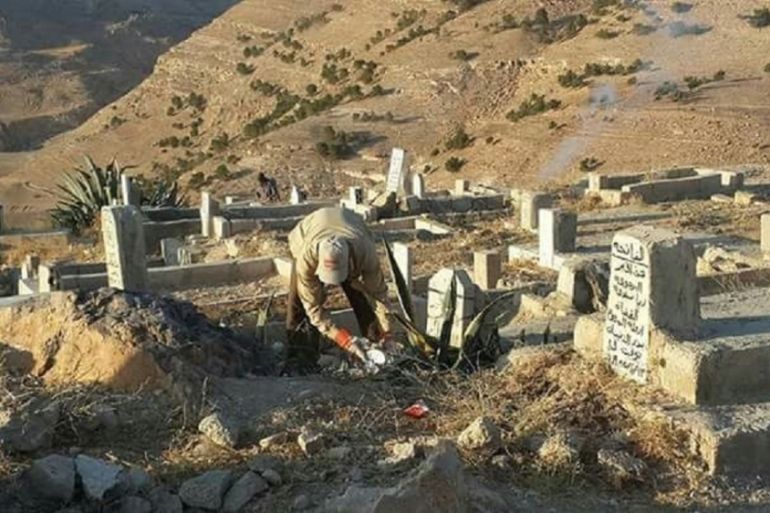Jordanians in Karak find unity in wake of tragedy
New initiatives aim to strengthen the town’s sense of community, after a December ISIL attack that killed 10 people.

Karak, Jordan – Late winter sunshine spills over Karak Castle, which has stood for centuries amid periods of dramatic change.
Karak’s historical significance dates back to when it was one of the capitals of the ancient Kingdom of Moab. Built in the 10th century by the Crusaders, the castle was later taken over by Saladin, who remains an icon in the Arab world for his victory in the 1187 Hattin battle against Crusader forces.
Keep reading
list of 4 itemsMoscow theatre attack suspects show signs of beating in court
Four men showing signs of severe beating charged over Moscow concert attack
Russia mourns Moscow concert hall attack victims as death toll rises to 137
In recent months, however, the castle has taken on more immediate significance, becoming a symbol of unity and resilience in the wake of a deadly attack by the Islamic State of Iraq and the Levant group (ISIL, also known as ISIS). On December 18, four gunmen holed themselves up in the castle and began firing at security forces, killing 10 people, including five Jordanian civilians, four police officers and a Canadian tourist.
“We confronted them [ISIL] with stones and with empty hands to tell them that they have no place here,” Wasfi Habashneh, one of several Karak residents who came to the defence of the castle, told Al Jazeera. The suspects were ultimately killed by security forces.
READ MORE: Jordan struggles to draw new tourists
!['The attack was a wakeup call for us to look after one another' [Areej Abuqudairi/Al Jazeera]](/wp-content/uploads/2017/03/5e2ed79ffd1d470c92d1c31dee98633a_18.jpeg)
Despite its devastating consequences, residents say the attack has helped to create a stronger sense of community in Karak, inspiring a number of new local initiatives.
“The attack was a wake-up call for us to look after one another,” said Ahmad Rawashdeh, a Karak resident and cofounder of Friends of the Castle, a community service initiative that was launched within days of the December attack.
“The best way to respond to terrorists is to build as much as they try to destroy,” Rawashdeh told Al Jazeera.
Friends of the Castle aims to reach out to residents in need by meeting gaps in local services. Rawashdeh and his fellow cofounders, who live in Karak’s city centre, were among hundreds of civilians who came to the castle to aid security forces and to help rescue tourists during the December attack. Now, they aim to use this renewed sense of community to serve the city in a volunteer capacity – everything from patching potholes to delivering food to elderly residents.
Their first activity, which included cleaning Muslim and Christian cemeteries in Karak and creating walking paths for visitors, was organised a few days after the ISIL attack.
READ MORE: Jordan’s ISIL campaign scares away tourists
Throughout winter, the group – which now boasts more than 200 volunteers and supporters – has served as an emergency hotline, repairing roofs damaged by heavy snow and rain, and providing clothing and heating for poor families in the area.
“This is coming from our hearts to our community,” said Habashneh, a cofounder of the group.
!['The temperature was below zero when I painted this, but I was determined to convey a message that ISIS can't turn us against one another' [Al Jazeera]](/wp-content/uploads/2017/03/5b8e92eec288435990521251095cd491_19.jpeg)
Another initiative launched in the wake of the Karak attack was the Mesha of Moab art club, which has been working to renovate and redecorate mosques and churches across Karak. They were inspired by the work of artist Izdihar Saoub, who painted a mural of Jesus on the walls of a Roman Catholic Church in the village of Ader in Karak, which residents believe was one of ISIL’s original targets.
“The temperature was below zero when I painted this, but I was determined to convey a message that ISIS can’t turn us against one another,” Saoub told Al Jazeera.
At the same time, the attack has rekindled interest in Karak’s famous castle, as more Jordanians have been visiting from across the country in recent days, according to local officials.
“We have not seen the city or the castle this lively with local tourists before,” Jaafar Shahadeh, the head of Karak’s tourism department, told Al Jazeera. He could not provide statistics on recent visitor numbers, but said that Jordanian schools and universities had been paying “solidarity visits” to the castle.
Among the recent first-time visitors was Leen Arabiat from the Jordanian town of Salt.

“I never thought of visiting the castle before the attack, because it was just history,” she told Al Jazeera. “It is interesting to see where the attack happened, as I could never have imagined something like this happening in Jordan.”
Overall, however, tourist numbers at Karak Castle and throughout Jordan have declined since the Arab Spring and the rise of ISIL. According to Shahadeh, Karak Castle used to attract an average of 200,000 tourists a year, but since 2011 that number has dropped to 25,000.
In their ongoing efforts to help revive the area, Friends of the Castle is planning to plant olive trees across the city, both to beautify and to provide a source of revenue for poor families.
Flipping through his phone, Rawashdeh stops on several images, including fallen Jordanian security agents and civilians, a solidarity protest on New Year’s Eve, and the town’s Christmas tree, decorated with photos of the victims.
“If ISIS aimed to divide Karak,” he said, “they left us as one body.”